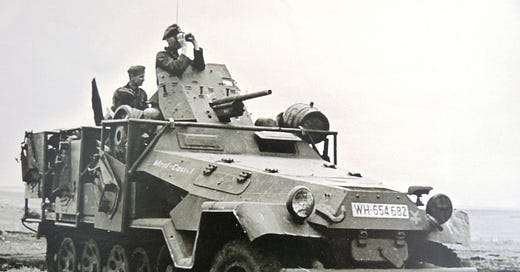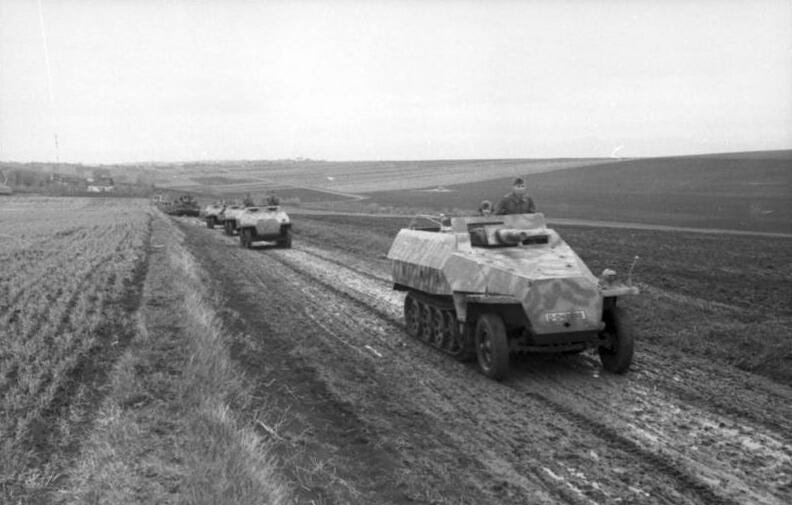Thirty Rules for the Leader of an Armored Panzer Grenadier Company
Armored Forces Newsletter (July 1943)
Originally published in the first issue of the Armored Forces Newsletter, the following article provides a series of precepts for the leaders of Panzer Grenadier companies equipped with armored vehicles.
Thirty Rules for the Leader of an Armored Panzer Grenadier Company
Before starting a road march, write down the route for the leaders of your platoons and truck convoys. Amazing misunderstandings result from the speaking of Russian place-names.
Maintain contact forwards and backwards. A complete company that arrives a little late is of greater value than a company commander who finds himself alone in an open field.
The slowest vehicle that plays an essential role in combat sets the pace for a company. Place it right behind the command vehicle.
Vehicle commanders observe standing up, even during bad weather and at night. Experience indicates that a sitting commander fails to observe properly.
When passing through narrow and difficult stretches of road, commanders guide their vehicles on foot.
When the trains find themselves with the [fighting echelon] of the company, detail armored personnel carriers to serve as tail-end vehicles. They get stalled vehicles moving again, rescue the crews of broken-down vehicles, and provide security towards the rear.
On bad roads, place your logistics vehicles and motorcycles with sidecars between armored personnel carriers and keep the towing cables handy. (Connect towing cables to the front axels of trucks and the side-car struts of motorcycles.) Load motorcycles without side cars on larger vehicles.
Your most energetic officer drives at the tail end of your company. He prevents unwarranted passing.1 Behind him drives a one-man motorcycle, which, from time-to-time drives forward to report delays and breakdowns.
Ruthlessly remove from your columns vehicles belonging to other units, telling them to follow in the rear, lest they take a wrong turn and lead the rest of your column with them.
In traffic jams, suppress the practice of moving forward a few meters at a time. This wastes fuel and wears out motors. Let the unit ahead of you move until it is out of sight before resuming your own movement. Units behind you will thank you for this. Nonetheless, remember that you are responsible to your commander for liaison and use your motorcycles to keep him informed.
During traffic jams, leaders should go forward to determine the cause. In most cases, it is a driver who has fallen asleep.
During night marches with lots of stops, form a “wake-up team” [Weckkommando] out of your motorcycle riders. Prior to the resumption of movement, wake up the drivers and your column will stay together. Inform the units behind you that movement is starting again.
Tactical leaders have no business driving vehicles.
When moving through sunken roads and hollows post single vehicles on the flanks in order to keep watch over higher ground. Maintain radio contact!
When hiding a forest, it is better to be too far into the woods by fifty meters than too far forward by a single centimeter.
If you send a single vehicle on reconnaissance, you’ll be very lucky if you see it again. Every patch of swamp, every fly in the carburetor will result in its loss. Therefore, send out two or more.
Never send your company into action without taking a good look at the ground.
Exploit the speed and effects of your heavy weapons in order to move forward and reduce losses.
When attacking in the wake of tanks and passing through the barrage, keep your distance from tank units. If you don’t, you will attract concentrated artillery fire. Drive as fast as you can when the last wave of tanks breaks through the main line of resistance. Experience indicates that Soviet anti-tank rifles come to life as soon as the last tank has passed.
When fighting in the main combat zone, support the tanks with all of your weapons. Don’t forget to provide protection towards the rear.
The driver’s submachine gun should not rest in its rack. It is a valuable weapon for mounted close combat.
Vehicles in the rear should take care lest their fire endanger men standing up to fire from vehicles located in front of them.
Where there is a danger of mines, follow the path [made by other vehicles.]
Every anti-tank weapon enjoys an advantage over you when it comes to readiness to fire. Even the odds with speed, exploitation of terrain, short halts for shooting, and energetic concentration of fire. At very short ranges, you can run over known anti-tank guns.
Only take shelter when enemy anti-tank fire or the terrain forces you do and bypassing is impossible. Otherwise, make good use of the armor [on your vehicles.] It saves blood.
When you and your vehicles go into a hedgehog, use standing reconnaissance teams to provide security at night. From time to time, let your motors run for fifteen minutes, to keep them warm in case you want to engage in mounted combat. If the enemy attacks, keep your fields of fire free of enemy forces and make use of your mobility.
Don’t carry fuel containers [jerry cans] on the outside of your vehicles. A tracer round can ignite them.
On the defensive, keep your vehicles under cover and, at the very least, organized into compact platoons, so that, occupied by drivers and the gunners of onboard weapons, they can quickly shift to counter-attack mode.
Make minimal use of your radio set. When the engine is turned off, the battery discharges itself in five hours. If you must use it, then run the engine for fifteen minutes every hour.
Lest warning of enemy anti-tank guns be delayed, only use your radio when [vehicle] commanders are wearing their headsets and throat microphones.2
Source: A typescript of the first issue of the Nachrichtenblatt der Panzertruppen can be found on the website of the German Federal Archive. Printed copies of subsequent issues are available at Sturmpanzer.com.
Photos: The photos used in this article, all of which originate with the German Federal Archive [Bundesarchiv], are made available through a creative commons license.
As the “most energetic officer” is located at the back of the company, the vehicles attempting to pass would necessarily belong to another unit.
This somewhat cryptic maxim may mean “if the situation is sufficiently fluid to warrant the use of radio, then make sure that everyone is on the net, and in a position to give immediate warning of danger.” It also suggests that the first vehicle to spot enemy anti-tank guns has but a few seconds to warn his comrades before falling prey to such weapons.







This is 90% applicable today. Prior fire support planning is critical if you are inside the range of friendly artillery. Air Support is critical and the FAC must be upfront. Radio chatter in US units is 85% too much and that is driven by higher HQ micromanagement. The reintroduction of motorcycles has been suggested and crushed time and time again. Huge mistake.
"At very short ranges, you can run over known anti-tank guns."
QOTD